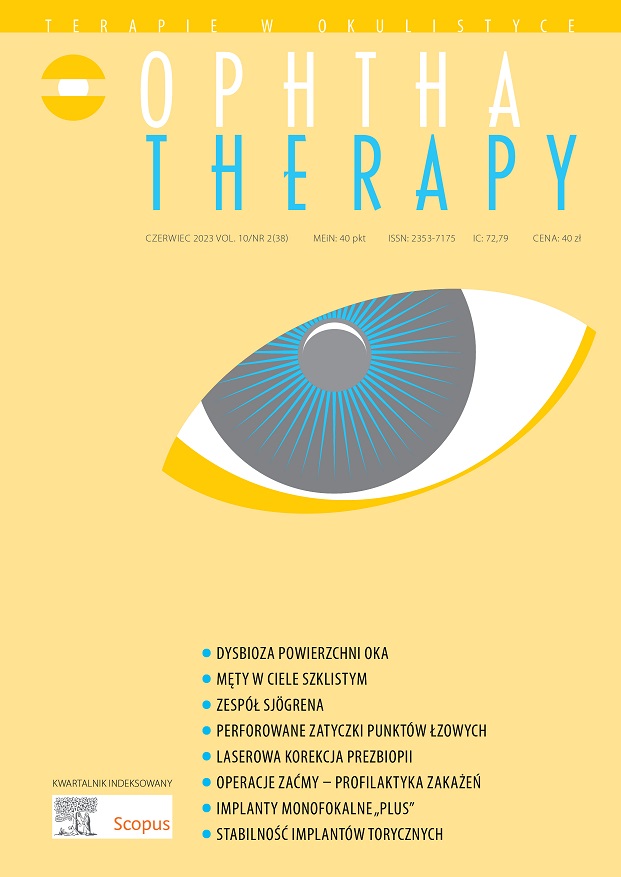Męty w ciele szklistym – etiologia, diagnostyka i leczenie Artykuł przeglądowy
##plugins.themes.bootstrap3.article.main##
Abstrakt
Męty w ciele szklistym są jedną z dolegliwości najczęściej zgłaszanych przez pacjentów okulistycznych. Etiologia mętów w ciele szklistym jest związana z naturalnym procesem starzenia się organizmu i zmianami zwyrodnieniowymi: pokrwotocznymi, pourazowowymi czy pozapalnymi. Diagnostyka i leczenie zależą od nasilenia dolegliwości. Proces tylnego odłączenia ciała szklistego wymaga szczególnie uważnego monitorowania z uwagi na ryzyko powikłań: przedarć lub odwarstwień siatkówki. Suplementacja preparatami zawierającymi substancje o właściwościach antyglikacyjnych i antyoksydacyjnych pozwala na zmniejszenie nasilenia dolegliwości zgłaszanych przez pacjentów.
Pobrania
##plugins.themes.bootstrap3.article.details##

Utwór dostępny jest na licencji Creative Commons Uznanie autorstwa – Użycie niekomercyjne – Bez utworów zależnych 4.0 Międzynarodowe.
Copyright: © Medical Education sp. z o.o. License allowing third parties to copy and redistribute the material in any medium or format and to remix, transform, and build upon the material, provided the original work is properly cited and states its license.
Address reprint requests to: Medical Education, Marcin Kuźma (marcin.kuzma@mededu.pl)
Bibliografia
2. Jamrozy-Witkowska A, Łukasik U, Skonieczna K et al. Zmiany w ciele szklistym związane z wiekiem – patogeneza, objawy i leczenie. Okulistyka. 2015; 1: 11-3.
3. de Smet MD, Gad Elkareem AM, Zwinderman AH. The Vitreous, the Retinal Interface in Ocular Health and Disease. Ophthalmologica. 2013; 230: 165-78.
4. Kim J, Lee HJ, Park IW et al. Comparison of Floaters after Cataract Surgery with Different Viscoelastics. Int J Med Sci. 2018; 15(3): 223-7.
5. Ankamah E, Sebag J, Ng E et al. Vitreous antioxidants, degeneration, and vitreo-retinopathy: exploring the links. Antioxidants. 2020; 9: 7.
6. Kamińska A, Dudek A. Rola ciała szklistego w procesie widzenia. Okulistyka. 2019; 3(XXII): 48-51.
7. Ankamah E, Green-Gomez M, Roche W et al. Dietary Intervention With a Targeted Micronutrient Formulation Reduces the Visual Discomfort Associated With Vitreous Degeneration. Transl Vis Sci Technol. 2021; 10(12): 19.
8. Deguine V, Menasche M, Ferrari P et al. Free radical depolymerization of hyaluronan by Maillard reaction products: role in liquefaction of aging vitreous. Int J Biol Macromol. 1998; 22: 17-22.
9. Deguine V, Labat-Robert J, Ferrari P et al. Aging of the vitreous body. Role of glycation and free radicals. Pathol Biol (Paris). 1997; 45: 321-30.
10. Sulochana KN, Ramprasad S, Coral K et al. Glycation and glycoxidation studies in vitro on isolated human vitreous collagen. Med Sci Monit. 2003; 9(6): BR260-4.
11. Sobol M, Oseka M, Kaercher Th et al. (BON 030) The effect of oral supplementation with L-lysine, hesperidin, proanthocyanidins, vitamin C and zinc on the subjective assessment of the quality of vision in patients with vitreous floaters. J Alzheimers Dis. 2018; 3(64): 1034.
12. Raczyńska K, Kokot W, Krajka-Lauer J et al. Jod w leczeniu zwyrodnienia ciała szklistego. Klin Oczna. 2004; 3(Suplement): 518-20.
13. Winkler R. Iodine – A Potential Antioxidant and the Role of Iodine/Iodide in Health and Disease. Nat Sci. 2015; 7: 548-57.
14. Broadhead GK, Hong T, Chang AA. To Treat or Not to Treat: Management Options for Symptomatic Vitreous Floaters. Asia Pac J Ophthalmol (Phila). 2020; 9(2): 96-103.
15. Souza CE, Lima LH, Nascimento H et al. Objective assessment of YAG laser vitreolysis in patients with symptomatic vitreous floaters. Int J Retina Vitreous. 2020; 6: 1.
16. Brasse K, Schitz-Valckenberg S, Junemann A et al. YAG laser vitreolysis for treatment of symptomatic vitreous opacities. Ophthalmologe. 2019; 116(1): 73-84.
17. Sobolewski P. Witreoliza i zwyrodnienie ciała szklistego – zapobieganie, leczenie i rozpoznawanie. Okulistyka po Dyplomie. 2015; 1: 11-3.
18. Milston R, Madigan MC, Sebag J. Vitreous floaters: Etiology, diagnostics, and management. Surv Ophthalmol. 2016; 61(2): 211-27.
19. Mason JO 3rd, Neimkin MG, Mason JU 4th et al. Safety, efficacy, and quality of life following sutureless vitrectomy for symptomatic vitreous floaters. Retina. 2014; 34(6): 1055-61.
20. Wagle AM, Lim W-Y, Yap T-P et al. Utility values associated with vitreous floaters. Am J Ophthalmol. 2011; 152(1): 60-5.
21. Sebag J. Floaters and the quality of life. Am J Ophthalmol. 2011; 152(1): 3-4.e1.
22. Kim Y-K, Young Moon S, Mi Yim K. Psychological Distress in Patients with Symptomatic Vitreous Floaters. J Ophthalmol. 2017; 2017: 3191576.

